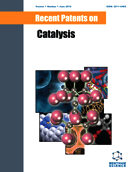Abstract
Isomerization of p-diisopropylbenzene (p-DIPB) to m-diisopropylbenzene (m-DIPB) was carried out using metal modified Hβ zeolites at high temperature and in the absence of a solvent. The metal cations used for the modification of Hβ were typical Lewis acidic cations Fe3+, Al3+, Ti4+, Sn4+ and Sb3+. The modified zeolite catalysts were heated at 120oC, and calcined at 280oC, and 550oC. They were characterized by XRD, FE-SEM, HR-TEM, FT-IR, N2-desorption (BET), NH3-TPD, Pyridine-IR and TGA techniques for structural, morphological, acidity and stability investigation. Particle size of the crystallites was determined by HR-TEM analysis and the size was in the range of 15-35 nm. At 250oC, Al- Hβ, Fe-Hβ and Ti-Hβ showed 68-75% conversion of p-DIPB and 42-54% selectivity towards m-DIPB. The calcination temperature had no effect on the activity. Isomerization increases with increased acidity. Thus, metal modified Hβ catalysts are excellent, efficient, and alternative heterogeneous catalysts for the isomerization of p-diisopropylbenzene (p- DIPB) to m-diisopropylbenzene (m-DIPB). This process is a greener alternative for the classical AlCl3 process as discussed in the article along with the relevant patents.
Keywords: Diisopropylbenzene, heterogeneous catalysis, isomerization, metal modified zeolite Hβ, rearrangement of dialkylbenzenes.
 8
8

